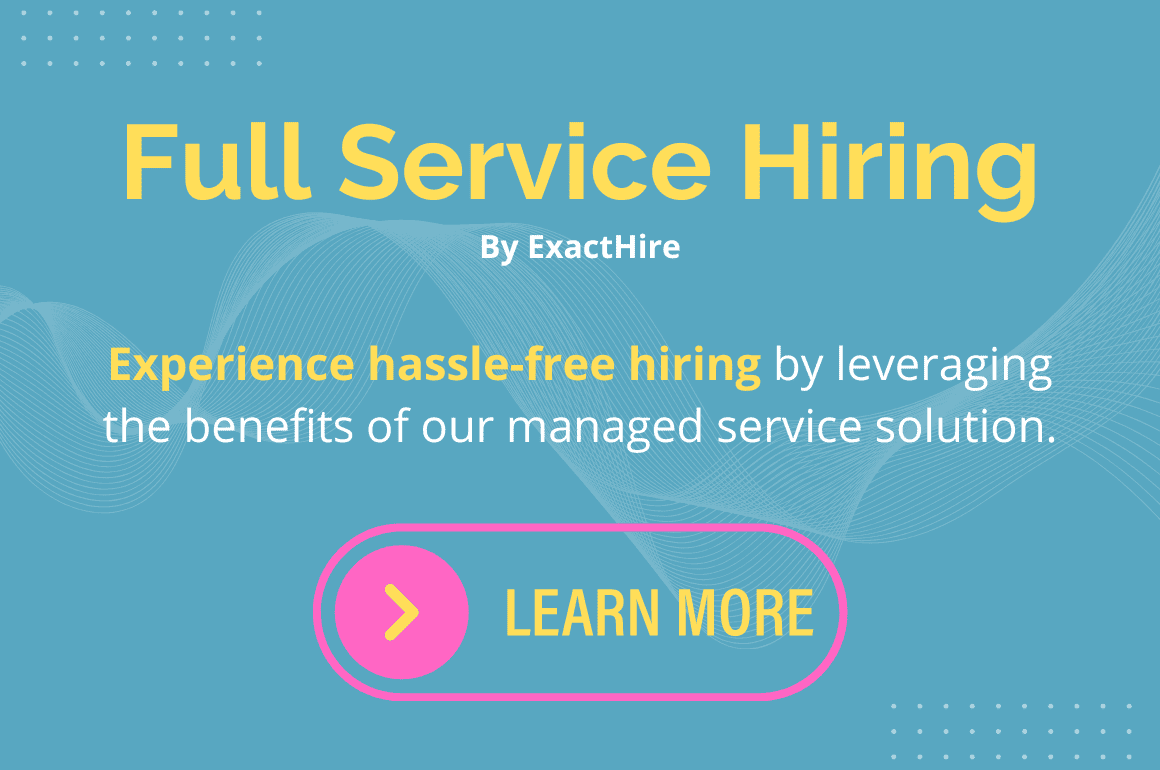How an ATS can overhaul your hiring efforts
To ensure you are doing your do diligence in getting the best possible candidates, you should consider using ExactHire’s ATS to cross reference hundreds of candidates against various criteria, so you can guarantee getting the most qualified candidates every time!
Making work life more efficient is one of the many goals for individuals in the recruiting world. It takes substantial amounts of time and money to find, evaluate and hire talent which fit into an organization’s culture. Using an Applicant Tracking System (ATS) can overhaul an organization’s hiring efforts, saving much needed time and money for the company.
According to a 2022 survey by PricewaterhouseCoopers, 39% of survey respondents said that the top two challenges in Human Resources today are recruiting/hiring and collecting/analyzing HR data analytics and insights. While these challenges can be tackled through manual recruiting efforts, manual recruitment yields more headaches and inefficiencies instead of simplicity. Using a robust ATS helps an organization consolidate job postings and applicant content in one central hub. That hub is accessible to permitted employees to view applicant information and interact with candidates expediting the hiring process.
How Does an ATS Help?
HR needs accessible data for reporting to management, departments, government entities and for their own internal purposes. A powerful ATS should allow quick access to reports such as Time to Fill and Time to Hire in addition to having the ability to build ad hoc reports. Analytics can also assist recruiters to get more bang for their buck with their recruitment budget. This is done by identifying where the most applicant traffic originates. This way they can focus their funding on the most productive sites.
After using recruitment analytics to find the most effective sources for candidates, an effective ATS should have an extensive library of job boards available for selection with the ability to automatically push job listings to key job boards. Time is of the essence, and recruiters cannot spend endless amounts of time posting to job boards A, B, and C, without tangible results. The competition for talent is fierce. If it takes too much time to post, screen and contact an applicant, that applicant will be hired by the organization’s competitor.
ATS Features
Candidates who apply for one job vacancy might not be the right fit for that particular role. They could possibly be a good fit for a different opening though. The convenience of copying an applicant to a different job listing saves the applicant time by not having to apply again and benefits the company by having that candidate’s info ready for review. For those job seekers who might walk in with a resume or stop by a company’s booth at a job fair, HR needs to have the ability to manually add that applicant to the ATS for consistency. Having an ATS that allows users the ability to tag particular skills on applicant records for positions helps recruiters. It allows them to examine talent that has shown interest in the company. Then they match those skills to the skills needed in vacant roles.
Locked file cabinets and desk drawers are not a secure way to house applicant files. Passing information manually between employees is a security risk. Using an applicant tracking system enhances safety and compliance. An applicant tracking system hosts candidates’ data in a secure, cloud-based central location. An ATS offers an organized, uniform place to screen, note and communicate with an applicant. Eliminate confusion regarding who has spoken to whom with the ability to see which employee has communicated with an applicant and what content was discussed. Keeping data in a central location with time stamped comments and communication provides quick access if there is a legal request for that data. While email is still a consistent means of contact with candidates, use an ATS with the ability to text applicants who opt in for texting for speedier communication.
Application Efficiency
Job seekers are examining the companies to which they apply. Is company A a better fit than company B? Consider the application process and how that is perceived by job seekers. If an organization is using paper applications, job seekers can legitimately question how technologically savvy the company is. QR codes generate opportunities for job seekers to apply with ease and convenience. A company’s job site must be mobile friendly. Job seekers use phones to apply. However, if a company has an electronic application, if it is too long the job seeker will stop applying and apply elsewhere. Having insights, such as Applicant Drop Off reporting, help recruiters identify challenges with the application process.
When selecting and implementing an ATS, knowing there is a responsive and personable support team is reassuring. Even for the most technologically savvy employees, questions will arise when using an ATS so having an accessible support team with the knowledge to answer the asked, and often unasked, questions is imperative. Service and support must be a priority item when selecting and implementing an ATS.
Conclusion
Automation saves time and money. Job seekers will not accept a long hiring process. If an organization does not effectively communicate and cycle the candidate efficiently through a short-phased process, talent will go somewhere else. Vacant jobs cost a company exorbitant amounts of money due to productivity loss. An organization cannot afford to have lost productivity. Or even overstretch existing employees as a temporary remedy to offset the open positions. If management is concerned that an ATS is too expensive for an organization, calculate and compare the loss of productivity. Then calculate valuable talent to the investment and cost savings of the implementation and use of an ATS. The cost-savings will be visible and reiterate the benefits that exist from using an ATS. Using an ATS will change the trajectory of recruitment to lead an organization along a path of success.

